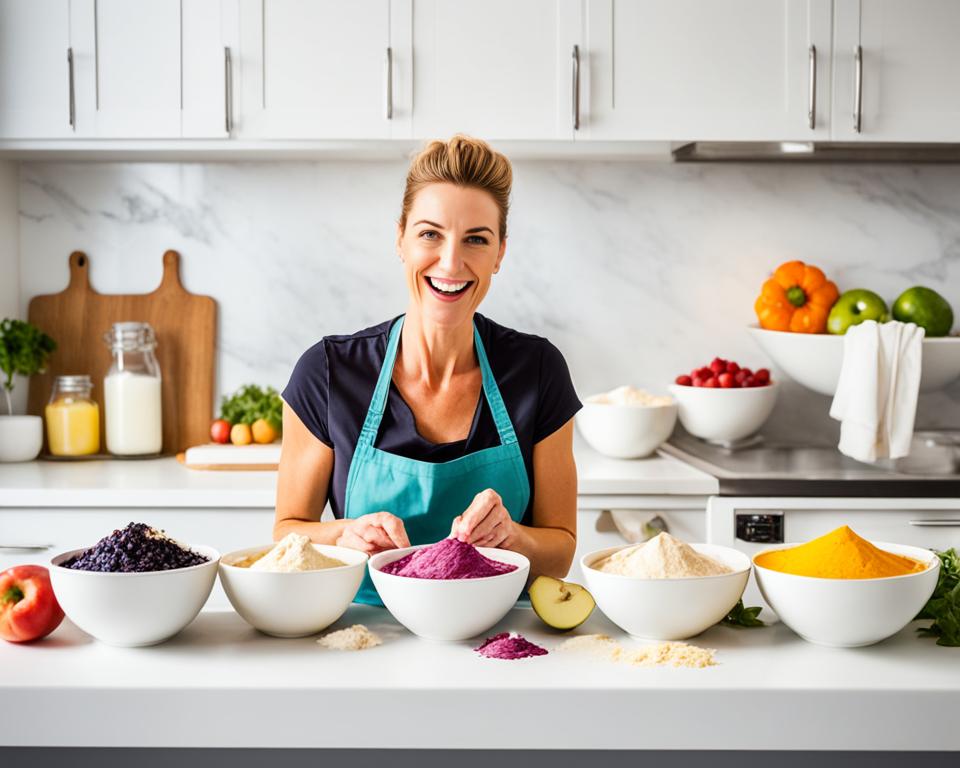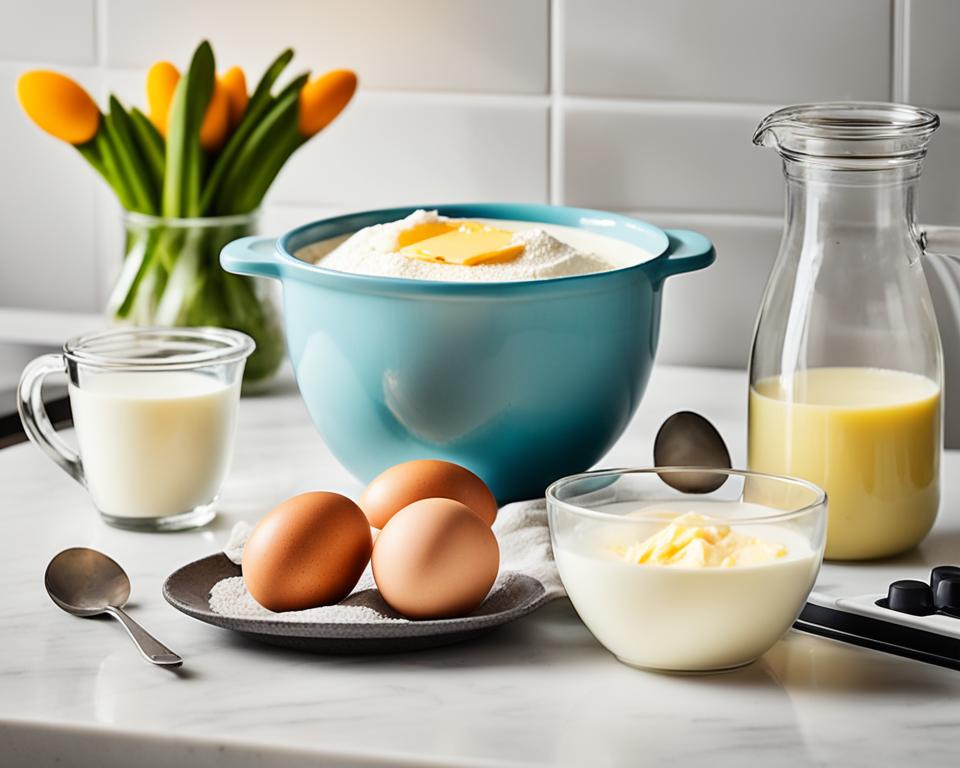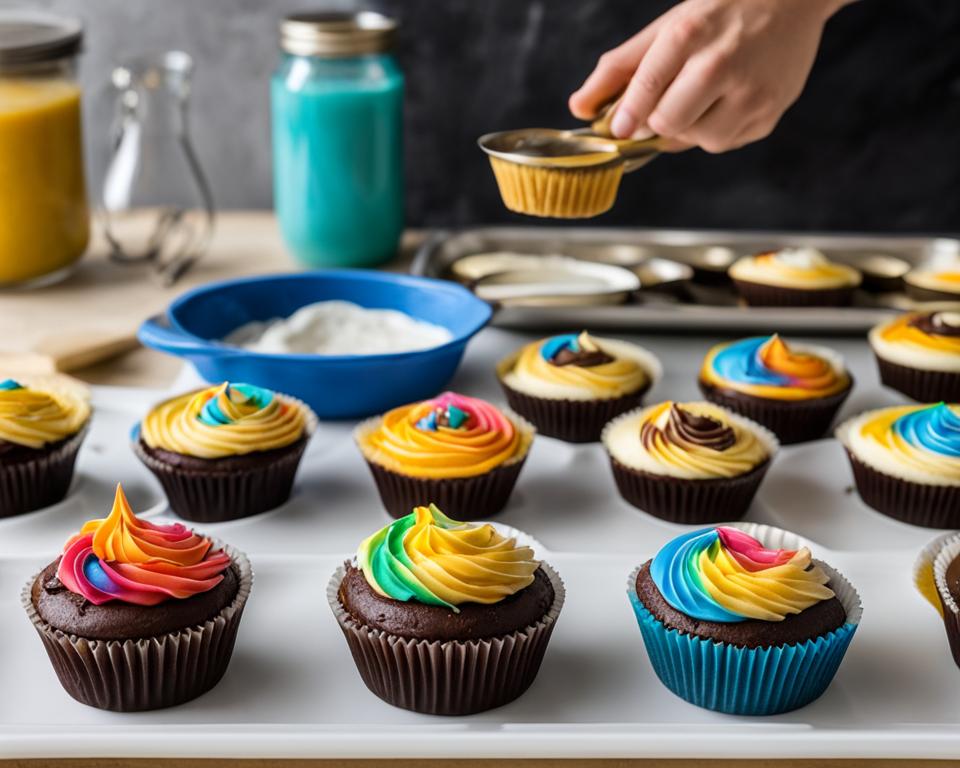Baking can be a delightful and rewarding hobby, but it can also come with its challenges, especially for beginners. With the right knowledge and techniques, however, baking can become a breeze. In this article, we will explore 16 quick and easy baking tips that will help improve your baking skills and ensure delicious results every time.
Key Takeaways:
- Understanding your oven and its quirks is essential for baking success.
- Knowing the characteristics of baking ingredients, such as baking powder and baking soda, is crucial for proper usage.
- Using a spatula while mixing can help achieve the perfect batter consistency.
- Ingredient substitutions should be done with caution as each ingredient plays a specific role in baking.
- Precise measurements are key to consistent and reliable baking results.
By incorporating these easy baking tips into your routine, you’ll be on your way to becoming a confident baker in no time. Let’s dive in and explore these tips further!
Understand Your Oven
Different ovens function differently, so it’s important to understand your oven’s quirks. Baking times and temperatures suggested in recipes are just guidelines and may vary depending on your oven’s size and heating capabilities. It’s recommended to check your baked goods a bit earlier than the suggested time and not to panic if they take longer to bake. Familiarize yourself with your oven’s nuances to achieve the best results.
Each oven has its own unique characteristics, and understanding them can greatly influence the outcome of your baking. While recipe instructions provide general temperature settings and baking times, it’s important to remember that these serve as a starting point.
The size and heating capabilities of your oven can affect how your baked goods turn out. A smaller oven may require less baking time, while a larger oven may need more time for the heat to distribute evenly. This is where knowing your oven’s quirks becomes essential.
One way to become familiar with your oven is to check your baked goods a bit earlier than the suggested baking time. By doing so, you can gauge how your oven performs and adjust accordingly. Don’t be alarmed if your items take slightly longer to bake than the recipe suggests.
Experimentation is key when it comes to understanding your oven. Take note of any variations you observe in baking temperature or cooking time. Keep a record of your adjustments and their corresponding results, so you can refer to it for future baking endeavors.
Remember, baking is a delightful journey that allows you to sharpen your skills and discover new possibilities. By understanding your oven and its unique traits, you can confidently navigate the world of baking and create delicious treats with perfection.
Understand the Ingredients
When it comes to baking, understanding the ingredients you use is essential for achieving delicious results. Let’s take a closer look at some key baking ingredients:
Baking Powder and Baking Soda
Baking powder and baking soda may seem similar, but they have different chemical properties. Baking powder is a combination of baking soda and acid, which helps in leavening baked goods. On the other hand, baking soda is alkaline on its own and requires an acid ingredient to neutralize it and create carbon dioxide gas, resulting in a rise.
Granulated Sugar and Castor Sugar
Granulated sugar is the most commonly used sugar in baking. However, some recipes may call for castor sugar (also known as superfine sugar) for better incorporation and smoother texture. If you don’t have castor sugar on hand, you can easily grind granulated sugar in a food processor or blender until it reaches a finer consistency.
Acid in Desserts
The presence of acid in desserts plays a crucial role in the baking process. Acidic ingredients like citrus fruits (such as oranges or lemons) contribute to both flavor and texture. The acidity helps activate baking soda, resulting in better leavening and a light, fluffy texture.
To better understand how these ingredients work and how to use them effectively in your baking, refer to the table below:
| Ingredient | Characteristics | Role |
|---|---|---|
| Baking Powder | Mixture of baking soda and acid | Leavening agent |
| Baking Soda | Alkaline | Requires acid to activate |
| Granulated Sugar | Coarse texture | Provides sweetness and structure |
| Castor Sugar (Superfine Sugar) | Finer texture | Enhances incorporation and texture |
| Acidic Ingredients (e.g., Citrus Fruits) | High acidity | Activates baking soda, adds flavor |
Understanding these ingredients will empower you to make informed decisions in your baking and achieve the perfect balance of flavors and textures.
Use a Spatula
When it comes to achieving the perfect batter consistency, a baking spatula is an indispensable tool in your kitchen arsenal. Whether you’re whipping up a batch of fluffy pancakes or preparing a cake batter, a spatula can make all the difference in ensuring that your dry and wet ingredients are thoroughly mixed.
As you combine the dry and wet ingredients in a bowl, it’s common for large particles to accumulate on the sides. This can result in an uneven mixture and affect the overall texture of your baked goods. However, with a rubber spatula, you can easily navigate the curved sides of the bowl and scrape off any excess batter. This allows for a more efficient and effective mixing process, ensuring that all ingredients are evenly distributed.
The versatile nature of a baking spatula also makes it ideal for folding delicate ingredients into your batter. Whether you’re incorporating whipped egg whites or gently folding in chocolate chips, a spatula offers the precision and control you need for a seamless integration.
Remember, achieving the right batter consistency is crucial for successful baking. With a trusty baking spatula by your side, you’ll be one step closer to creating sublime treats that are sure to impress.
Substitute Carefully
Baking is a science, and ingredient substitutions should be done with caution. Each ingredient has a specific role, and substituting without understanding the logic behind it can lead to undesired results. It’s important to consider the characteristics of each ingredient before making substitutions.
For example, when substituting whole wheat flour for all-purpose flour, it’s important to note that whole wheat flour is drier and absorbs more moisture. This means that you may need to increase the amount of liquid in the recipe to maintain the desired consistency of the batter or dough.
An interesting and healthy substitution to consider is using mashed bananas as a replacement for eggs. Mashed bananas not only add moisture to baked goods but also provide natural sweetness. However, it’s important to be mindful of the flavor profile and the recipe’s compatibility with this substitution. Mashed bananas work well in recipes like chocolate cakes, where their flavor complements the overall taste. However, they may not work as effectively in delicate desserts like macarons, where the texture and structure heavily rely on eggs.
Remember, every substitution can significantly impact the final outcome of your baked goods, so it’s crucial to choose substitutions wisely based on the characteristics and roles of each ingredient.
| Ingredient | Substitute |
|---|---|
| Eggs | Mashed bananas |

Precise Measurements
Precise measurements are crucial in baking to achieve consistent results. Whether you’re a seasoned baker or just starting out, accurate measuring ensures that your baked goods turn out as intended. From delicate pastries to fluffy cakes, every ingredient plays a vital role, and even small deviations can significantly impact the final outcome.
While a weighing scale is the gold standard for precise measurements, not everyone may have one at home. In such cases, investing in good quality measuring cups and spoons is essential. These tools allow you to measure both liquid and dry ingredients accurately.
When measuring dry ingredients like flour or sugar, use a spoon to transfer the ingredient into the measuring cup, filling it to the desired level. Then, level off the excess with a straight edge, such as a knife or the back of a spatula. This ensures that the measurement is precise, without any excess or insufficient amounts.
“Accurate measurements are the backbone of successful baking. They provide the necessary balance of ingredients, leading to consistent and delicious results.”
Balance the Flavor
When it comes to baking, achieving the perfect balance of flavors is essential for creating a delightful taste experience. Adding salt and sweetness in the right proportions can elevate the overall flavor profile of your baked goods.
To enhance the sweetness and bring out the flavors even more, consider adding a pinch of salt to your cake batter or cookies. Salt acts as a flavor enhancer and can help balance the sweetness, creating a more complex and satisfying taste. However, it’s crucial to use salt sparingly, as too much can overpower the other flavors and make your baked goods excessively salty.
When using salt, opt for sea salt or kosher salt instead of table salt, as they have a milder flavor and dissolve more easily. Incorporate the salt into the dough or batter gradually, tasting along the way to ensure the desired balance is achieved.
Note: When adding salt to your baked goods, be mindful of any dietary restrictions or preferences of your intended audience.
Quick Tip: Flavored Salts
If you want to add an extra layer of complexity to your baked goods, consider experimenting with flavored salts. These specialty salts, such as smoked salt or truffle salt, can impart unique and subtle flavors to your recipes. Just remember to use them sparingly, as their flavors can be quite potent.
| Balancing Flavors in Baking | |
|---|---|
| Ingredient | Function |
| Salt | Enhances sweetness and balances flavors |
| Sweeteners | Adds sweetness and depth of flavor |
| Acidic ingredients | Brings brightness and cuts through richness |
| Spices and herbs | Enhances complexity and adds aromatic notes |
By carefully balancing the flavors in your baked goods, you can create a harmonious taste sensation that will delight your taste buds. Experiment with different combinations of salt, sweetness, and other flavor enhancers to discover your perfect balance.
Prep the Pan
Prepping the baking pan is a crucial step to ensure your baked goods come out easily and intact. By following a few simple techniques, you can prevent sticking and make the removal process a breeze.
First, it’s essential to thoroughly grease the pan. This can be done using butter, cooking spray, or vegetable oil. Apply a generous amount to all sides of the pan, ensuring full coverage. Greasing the pan creates a non-stick surface that allows your baked goods to slide out effortlessly.
To further enhance the non-stick feature, place a sheet of parchment paper in the bottom of the pan. This additional layer acts as a protective barrier and prevents the batter from sticking to the pan. It also makes cleanup much easier!
Once the pan is greased and lined with parchment paper, you’re ready to add your batter or dough. The prepared pan will ensure even baking and prevent any mishaps when it’s time to remove your masterpiece from the pan.
If you need visual guidance on how to prep a baking pan, take a look at the following image:
Benefits of Prepping the Pan:
- Prevents sticking and ensures easy removal of baked goods
- Creates a non-stick surface for effortless sliding
- Facilitates even baking
- Streamlines the cleanup process
Follow the Recipe Religiously
Baking recipes are a treasure trove of culinary wisdom, honed through countless trials and adjustments. To achieve the delectable outcomes these recipes promise, it’s crucial to follow them closely, step by step. Each instruction is carefully crafted to ensure the perfect balance of flavors and textures.
A prime example of the importance of recipe adherence is the technique of creaming butter with sugar. Creaming involves beating softened butter and granulated sugar together until light and fluffy, creating air pockets that contribute to a tender and moist crumb in cakes and cookies. It’s a crucial first step that sets the foundation for a successful bake.
In addition to specific techniques like creaming, the recipe order itself is carefully structured to yield the best results. Each ingredient is added at a particular stage to establish the desired texture and flavor. A slight alteration in the order can have a significant impact on the final product.
To illustrate the significance of recipe order, consider a classic chocolate cake recipe. Creaming the butter and sugar first aerates the batter, followed by the addition of eggs, which provide structure and moisture. Alternate additions of dry and wet ingredients ensure their even distribution, resulting in a uniformly tender and moist cake.
| Step | Ingredient | Action |
|---|---|---|
| 1 | Butter | Cream with sugar |
| 2 | Eggs | Add one at a time, beat well |
| 3 | All-Purpose Flour, Cocoa Powder | Sift together |
| 4 | Baking Powder, Baking Soda, Salt | Add to dry ingredients |
| 5 | Brewed Coffee, Milk | Add gradually, alternating with dry ingredients |
| 6 | Vanilla Extract | Stir in |
| 7 | Bake | Follow recipe’s recommended temperature and time |
Following the recipe meticulously ensures that you’ve done your due diligence, setting yourself up for a deliciously successful outcome. So, resist the temptation to deviate and trust the expertise behind each recipe.
Keep Ingredients at Room Temperature
For optimal baking results, it’s crucial to use room temperature ingredients for certain key elements like eggs, butter, and milk. Room temperature ingredients can significantly affect the texture and overall outcome of your baked goods.
When baking, using softened butter is essential for achieving a smooth and creamy consistency. Softened butter is easier to cream with other ingredients, ensuring a well-incorporated and fluffy batter. To soften butter, simply leave it at room temperature for about 30 minutes until it’s soft to the touch.
Room temperature eggs and milk also play a crucial role in baking. Adding cold eggs or milk to your batter can cause it to curdle or create an uneven mix. Room temperature eggs and milk blend more easily with the other ingredients, resulting in a consistent texture and flavor in your baked goods.
However, it’s essential to note that not all recipes require room temperature ingredients. Some recipes specifically call for chilled ingredients or cold butter. Always follow the recipe instructions to ensure the best possible outcome for your baked treats.
Now let’s take a look at a simple table summarizing the benefits of using room temperature ingredients:
| Ingredient | Benefits of Room Temperature |
|---|---|
| Eggs | Allows for better incorporation with other ingredients |
| Butter | Easier to cream, resulting in a smoother texture |
| Milk | Creates a consistent mix and improves overall texture |
By using room temperature ingredients when appropriate, you can ensure a more successful and enjoyable baking experience.

Preheat Oven
Preheating the oven is a crucial step in baking that should never be overlooked. By preheating, you ensure that the oven reaches the desired temperature before placing your baked goods inside. This is essential for consistent and even baking.
When preheating your oven, refer to the temperature specified in your recipe. Set the oven to the recommended temperature and allow it to fully heat up. Most ovens have a preheat indicator that turns off once the desired temperature is reached. This may take a few minutes, depending on your oven’s efficiency.
Once your oven is preheated, it’s time to position your baking pan. For optimal heat distribution, place the pan on the middle rack of the oven. This helps ensure that your baked goods bake evenly from top to bottom.
Remember, every time you open the oven door, you release heat and disrupt the baking process. So, it’s best to minimize opening the door during baking to maintain a consistent temperature inside the oven.
Keep these tips in mind to preheat your oven correctly and achieve perfect baking results every time.
Conclusion
By incorporating these quick and easy baking tips into your routine, you can become a more confident and successful baker. Baking is both a skill and a science, requiring time and patience to master. It’s important to remember that even the most seasoned bakers started as beginners and learned through practice.
Don’t be discouraged by a few failed attempts – every mistake is an opportunity to learn. Keep learning and experimenting with new recipes and techniques. As you gain experience, you’ll develop an intuition for baking and be able to adjust recipes to suit your taste.
Remember, baking is not just about the end result; it’s about the journey. Enjoy the process and have fun in the kitchen. Share your delicious creations with family and friends, and watch as their faces light up with delight. Happy baking!
FAQ
What is the importance of understanding your oven?
Different ovens function differently, so understanding your oven’s quirks is important for baking. Baking times and temperatures may vary, so it’s recommended to check your baked goods earlier than suggested and familiarize yourself with your oven’s nuances.
What is the difference between baking powder and baking soda?
Baking powder is a combination of baking soda and acid, while baking soda is alkaline on its own. Baking soda should only be used in recipes with acid to neutralize it. It’s also important to grind granulated sugar into castor sugar for better incorporation in baked goods.
How can a spatula help with baking?
A rubber spatula is a handy tool for achieving the perfect batter consistency. It can easily move through the curved shape of the bowl, ensuring thorough mixing and a uniform batter texture.
Can I substitute ingredients in baking recipes?
Ingredient substitutions should be done with caution, as each ingredient has a specific role. Understanding the characteristics of each ingredient is crucial before making substitutions.
How important are precise measurements in baking?
Precise measurements are crucial for consistent baking results. A weighing scale is the ideal tool for accuracy, but investing in good measuring cups and spoons is essential if you don’t have one.
How can I balance flavors in my baked goods?
Adding a pinch of salt to the cake batter or cookies can enhance the sweetness and bring out the flavors even more. Finding the right balance of ingredients is crucial for a harmonious flavor profile.
How can I prepare the pan for baking?
Prepping the pan is important to prevent sticking and ensure easy removal of baked goods. Thoroughly greasing the pan and placing a sheet of parchment paper can create a non-stick surface.
Why should I follow a baking recipe closely?
Baking recipes are the result of numerous trials and adjustments, so following them closely ensures the best possible results. Each step is carefully crafted to achieve the desired outcome.
Should ingredients be at room temperature for baking?
For certain ingredients like eggs, butter, and milk, keeping them at room temperature is crucial for optimal baking results. Softened butter is easier to cream, and room temperature ingredients mix more evenly.
Why is preheating the oven important?
Preheating the oven ensures that it reaches the desired temperature and provides consistent heat throughout the baking process. Placing the baking pan on the middle rack helps with even heat distribution.
How can I become a better baker?
Incorporating these quick and easy baking tips into your routine can help you become a more confident and successful baker. Baking is a skill and science that requires time, patience, and continuous learning.




